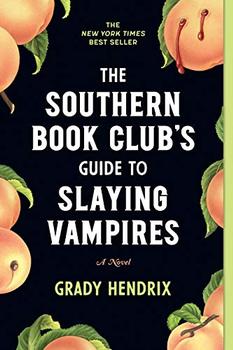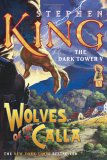Summary | Excerpt | Reading Guide | Reviews | Beyond the book | Read-Alikes | Genres & Themes | Author Bio

Grady Hendrix's novel The Southern Book Club's Guide to Slaying Vampires revolves around Patricia Campbell, a 1990s small-town matriarch. The stay-at-home mother of two lives an unremarkable existence, going about her day driving the kids to school, cleaning house, catering to the whims of her successful husband and caring for his elderly mother. Her social circle consists of other women living similarly constrained lives who get together once a month to ostensibly discuss true-crime books (but really to drink white wine and gossip). Their predictable world is disrupted by the arrival of James Harris, a handsome, charismatic stranger who quickly insinuates himself into their community. As bizarre attacks occur and children from the poor section of town start dying, Patricia begins to wonder if James could be responsible or if, as her husband insists, she has simply been reading too many books about mass murderers. She enlists her fellow housewives to help her investigate—with unexpected and harrowing results.
One might expect from the book's title and description that this would be a lighthearted, tongue-in-cheek take on the well-worn vampire and horror genres, and indeed, the novel starts out in that vein. For example, in describing an early encounter between two of the women, the author writes:
Patricia knew that Maryellen was a Yankee from Massachusetts who told everyone that she was a feminist. And Kitty was one of those big women who wore the kind of clothes people charitably referred to as "fun" – baggy sweaters with multicolored handprints on them, chunky plastic jewelry. Patricia suspected that getting entangled with women like this was the first step on a slippery slope that ended with her wearing felt reindeer antlers at Christmas.
This narrative style continues on for the first quarter of the book, and it's entertaining enough to keep the reader engaged. Perhaps the most impressive aspect of the author's technique, though, is the way he gradually transitions the story from what seems like a horror spoof to a true horror story with characters and a plot in which the reader becomes deeply invested. As the plot darkens, there are passages that are humorous but terrifying at the same time, a tricky balance to achieve but one Hendrix manages with remarkable success.
Several passages are quite gory. The author warns readers in the prologue that "this story ends in blood" and that's certainly the case—there's a lot of blood in the middle as well. Given the somewhat frothy tone of the first part of the narrative, the "ick-factor" of these encounters was initially shocking; the level of violence seemed out of synch with my expectations for the novel. While I came to anticipate these sections, I was nonetheless repulsed by the author's excessively detailed, no-holds-barred descriptions. They're for the most part skimmable but not entirely avoidable, so those who are bothered by intensely gruesome books will want to give this one a pass.
That said, if you don't mind the occasional explicitly violent scene, The Southern Book Club's Guide to Slaying Vampires is a great escape; its compelling characters, fast pace and unique modern take on vampire literature make it a worthwhile read. I'd recommend it for book groups, as it raises good discussion questions surrounding friendships, spousal relationships and community responsibility.
![]() This review was originally published in The BookBrowse Review in April 2020, and has been updated for the
June 2021 edition.
Click here to go to this issue.
This review was originally published in The BookBrowse Review in April 2020, and has been updated for the
June 2021 edition.
Click here to go to this issue.

If you liked The Southern Book Club's Guide to Slaying Vampires, try these:

by Elizabeth Kostova
Published 2006
What does the legend of Vlad the Impaler have to do with the modern world? Is it possible that the Dracula of myth truly existed—and that he has lived on, century after century, pursuing his own unknowable ends? Elizabeth Kostova's debut novel is an adventure of monumental proportions, a relentless tale that blends fact and fantasy, ...

by Stephen King
Published 2005
The Wolves of Thunderclap and their unspeakable depredation are coming. To resist them is to risk all, but these are odds the gunslingers are used to, and they can give the Calla-folken both courage and cunning.
Your guide toexceptional books
BookBrowse seeks out and recommends the best in contemporary fiction and nonfiction—books that not only engage and entertain but also deepen our understanding of ourselves and the world around us.